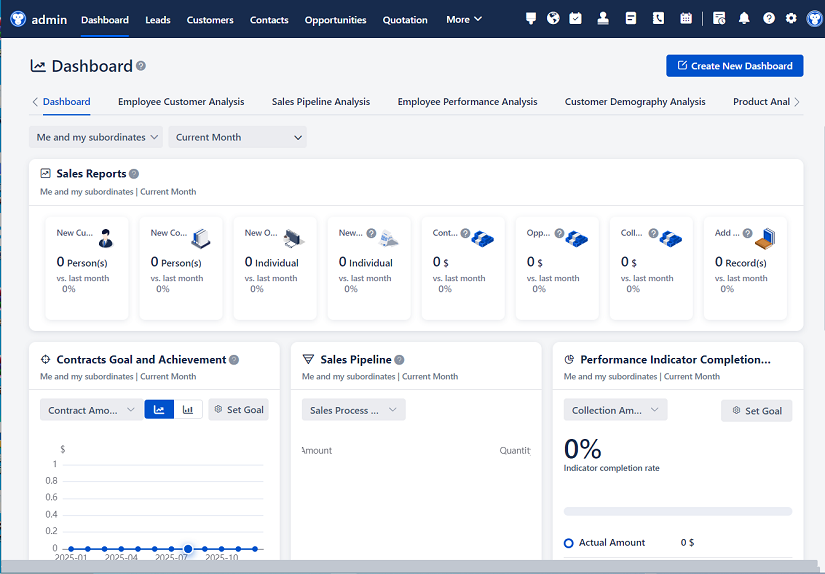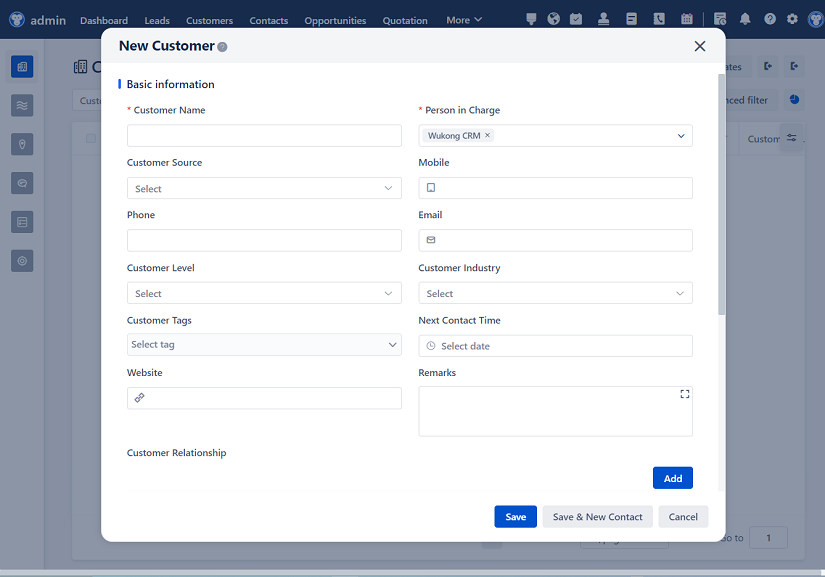
△Click on the top right corner to try Wukong CRM for free
So, you know, when people talk about CRM systems—Customer Relationship Management systems—they’re usually thinking about how companies keep track of their customers, right? Like, who bought what, when they last contacted support, or even what kind of emails they respond to. But honestly, behind all that smooth interface and neat dashboards, there’s a whole world of programming languages doing the heavy lifting. And I’ve been curious lately—what are the actual languages developers use to build these things?
Well, let me tell you, it’s not just one language. It’s actually a mix, depending on what part of the system you're building. For example, if you’re working on the backend—the part that handles data storage, business logic, user authentication—you’re probably going to see a lot of Java. Yeah, Java. I know it sounds kind of old-school, but trust me, in enterprise environments, Java is still super popular. Why? Because it’s stable, it scales well, and there are tons of frameworks like Spring that make building complex applications way easier.
Free use of CRM system: Free CRM
And speaking of frameworks, have you heard of Spring Boot? It’s basically a game-changer for Java developers building CRM backends. It lets you set up REST APIs quickly, connect to databases without writing a ton of boilerplate code, and handle security with tools like Spring Security. So yeah, if you walk into a big company using a custom CRM, chances are good that Java and Spring are running the show behind the scenes.
But wait—what about Python? Oh man, Python is everywhere these days. I mean, it’s not always the first choice for full-scale CRM platforms, but it’s definitely used, especially when you need something fast and flexible. A lot of startups or smaller teams go with Python because it’s easy to learn and has great libraries. Django and Flask are two of the most common web frameworks, and they’re perfect for prototyping or building lightweight CRM modules.

I remember talking to a developer friend who worked at a small SaaS company, and they used Django to build their internal CRM tool. He said it took them only a few weeks to get a functional version up and running. That’s the power of Python—it’s clean, readable, and gets stuff done without making you jump through hoops.
Now, let’s switch gears a bit and talk about the frontend—the part users actually interact with. This is where JavaScript really shines. I mean, come on, almost every modern web application uses JavaScript in some form. Whether it’s plain JS or more advanced frameworks like React, Angular, or Vue.js, you can’t escape it when building a CRM interface.
React, in particular, has become super popular. I’ve seen so many CRM dashboards built with React because it makes it easy to create dynamic, responsive UIs. You know, like when you click a button and customer info pops up instantly without reloading the page? That’s React doing its thing. Plus, it plays nicely with other tools and APIs, which is crucial when you’re pulling data from different sources in a CRM.

And don’t forget Node.js! That’s JavaScript on the server side. Some teams actually use Node.js for the backend too, especially if they want to keep everything in JavaScript. It’s fast, event-driven, and works well for real-time features—like live chat or notifications in a CRM. So if your team already knows JavaScript well, going full-stack with Node might make a lot of sense.
But here’s something interesting—not all CRMs are built from scratch. A lot of companies use platforms like Salesforce, HubSpot, or Microsoft Dynamics. And guess what? Even those have their own programming ecosystems. Take Salesforce, for example. They use a language called Apex, which looks a lot like Java but runs on their cloud platform. Then there’s Visualforce and Lightning Web Components for the frontend. So if you’re customizing a Salesforce CRM, you’re not writing plain HTML and JS—you’re learning their specific tools.
It’s kind of like being inside a walled garden. You get a lot of power and integration, but you also have to play by their rules. Still, for businesses that don’t want to build everything themselves, it’s a solid option.

Oh, and databases—can’t forget those. A CRM lives and dies by its data. So while programming languages handle the logic, you’ve got to store all that customer info somewhere. SQL-based databases like PostgreSQL or MySQL are common, and developers often use languages like Java or Python to interact with them via ORMs (Object-Relational Mappers). These help bridge the gap between code and database tables so you don’t have to write raw SQL all the time.
But nowadays, NoSQL databases like MongoDB are also getting attention, especially when dealing with unstructured data—like social media interactions or chat logs. And fun fact: Node.js works really well with MongoDB because both use JSON-like formats. So if your CRM needs to handle messy, evolving data, that combo could be a winner.

Let’s not ignore PHP either. I know some people roll their eyes at PHP, but it’s still widely used, especially in older systems or content-heavy CRMs. WordPress, for instance, powers a lot of websites, and with plugins like WP-CRM System, you can actually build a basic CRM on top of it. Plus, Laravel—a modern PHP framework—has made PHP development way more enjoyable. It’s got routing, authentication, and database tools baked in, so it’s not the clunky PHP of the early 2000s anymore.
Then there’s C#. If you’re in a Microsoft-heavy environment, you’ll probably run into .NET and C# a lot. Microsoft Dynamics, for example, is deeply integrated with the .NET ecosystem. So if a company is already using Windows servers and Azure, it makes sense to stick with C# for custom CRM development. It’s powerful, type-safe, and integrates smoothly with other Microsoft tools.
And what about mobile access? More and more, people want to check their CRM on the go. So you’ve got native apps built with Swift (for iOS) or Kotlin (for Android), or cross-platform solutions like React Native or Flutter. These let developers write once and deploy on both platforms, which saves time and money. I’ve seen sales teams love having a mobile CRM app that syncs in real time—that kind of convenience really boosts productivity.
Security is another big deal. I mean, CRMs hold sensitive customer data—emails, phone numbers, purchase history—so you can’t cut corners. Languages like Java and C# have strong typing and built-in security features, which helps reduce vulnerabilities. But no matter what language you use, you’ve got to follow best practices: input validation, encryption, secure authentication (like OAuth), and regular updates.
Testing is huge too. You don’t want your CRM crashing during a big sales push. So developers use testing frameworks—JUnit for Java, pytest for Python, Jest for JavaScript—to make sure everything works as expected. Automated testing saves so much time and prevents embarrassing bugs from going live.
Deployment and DevOps are part of the picture as well. Once the code is written, you’ve got to get it online. Tools like Docker, Kubernetes, and CI/CD pipelines help automate deployment, especially in cloud environments like AWS or Azure. And again, the choice of programming language can affect how easy this is. For example, Node.js apps are lightweight and container-friendly, while Java apps might need more resources but offer better performance under heavy load.
Now, here’s a thought: what if you want AI features in your CRM? Like predicting which leads are most likely to convert? That’s where Python really steps up. With libraries like scikit-learn, TensorFlow, or PyTorch, you can plug machine learning models right into your CRM. Imagine automatically scoring leads based on past behavior—that’s not sci-fi, that’s happening today.
And APIs? Super important. Most CRMs need to talk to other systems—email services, payment gateways, marketing tools. So developers use languages like Python or JavaScript to build and consume RESTful APIs or GraphQL endpoints. It’s all about integration. The more connected your CRM is, the more valuable it becomes.
So, putting it all together: there’s no single “best” language for CRM development. It really depends on your team, your budget, your existing tech stack, and what you’re trying to achieve. Big enterprises might lean on Java or C# for stability. Startups might choose Python or Node.js for speed and flexibility. And if you’re customizing an existing platform, you’ll work with whatever language that platform supports.
One thing’s for sure—CRM systems are more than just contact lists. They’re complex applications that require thoughtful architecture and skilled developers. And the programming language you pick shapes how easy or hard it is to build, maintain, and scale.
At the end of the day, it’s not about which language is “coolest,” but which one helps you solve real business problems efficiently. Whether it’s Java keeping a Fortune 500 company’s CRM running smoothly or a solo founder using Python to launch a niche tool, the goal is the same: better customer relationships through smart software.
FAQs (Frequently Asked Questions):
Q: Can I build a CRM with just JavaScript?
A: Absolutely! With Node.js on the backend and React or Vue on the frontend, you can build a full-featured CRM using only JavaScript. It’s especially popular for startups and agile teams.
Q: Is Python good for large-scale CRM systems?
A: Python can handle large systems, especially with frameworks like Django and good architecture. However, for very high-performance or enterprise-level needs, Java or C# might be preferred.
Q: Do I need to learn multiple programming languages to work on CRM development?
A: Not necessarily, but it helps. Most CRM projects involve both frontend and backend work, so knowing one language for each (like JavaScript and Python) gives you a big advantage.
Q: What language does Salesforce use?
A: Salesforce uses Apex for backend logic and Lightning Web Components (based on JavaScript) for the frontend. You can’t use standard languages directly on their platform.
Q: Which language is easiest for beginners to start with for CRM development?
A: Python is often recommended for beginners because of its simple syntax and rich ecosystem. Paired with Django, it’s a great starting point for learning CRM development.
Q: Are there any CRM platforms that allow custom coding in any language?
A: Most hosted platforms (like Salesforce or HubSpot) limit you to their ecosystem. But open-source CRMs like SuiteCRM or Odoo let you modify the code using PHP or Python, giving you more freedom.
Q: How important is database knowledge when developing a CRM?
A: Extremely important. Since CRMs are data-heavy, understanding databases—both SQL and NoSQL—and how to interact with them using your chosen language is essential.
Q: Can I integrate AI into a CRM using JavaScript?
A: Yes, though Python is more commonly used for AI/ML. However, JavaScript libraries like TensorFlow.js allow you to run machine learning models directly in the browser or Node.js environment.
Related links:
Free trial of CRM
Understand CRM software

△Click on the top right corner to try Wukong CRM for free